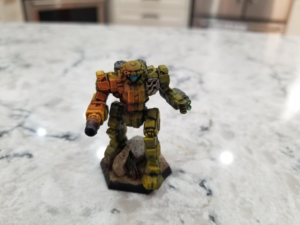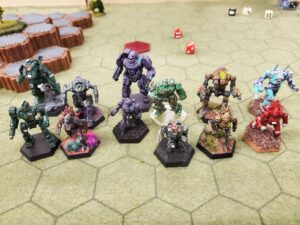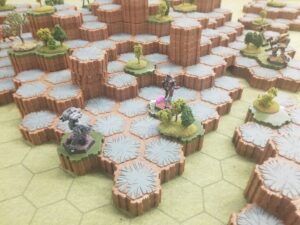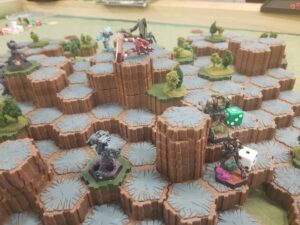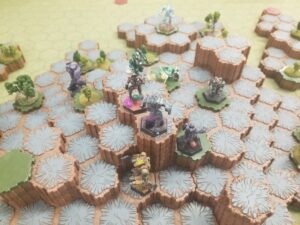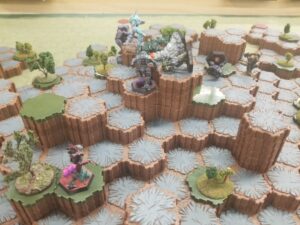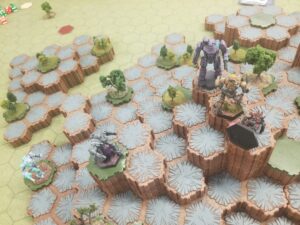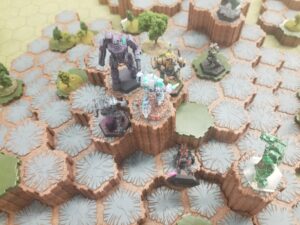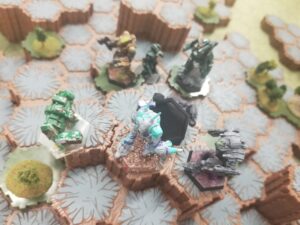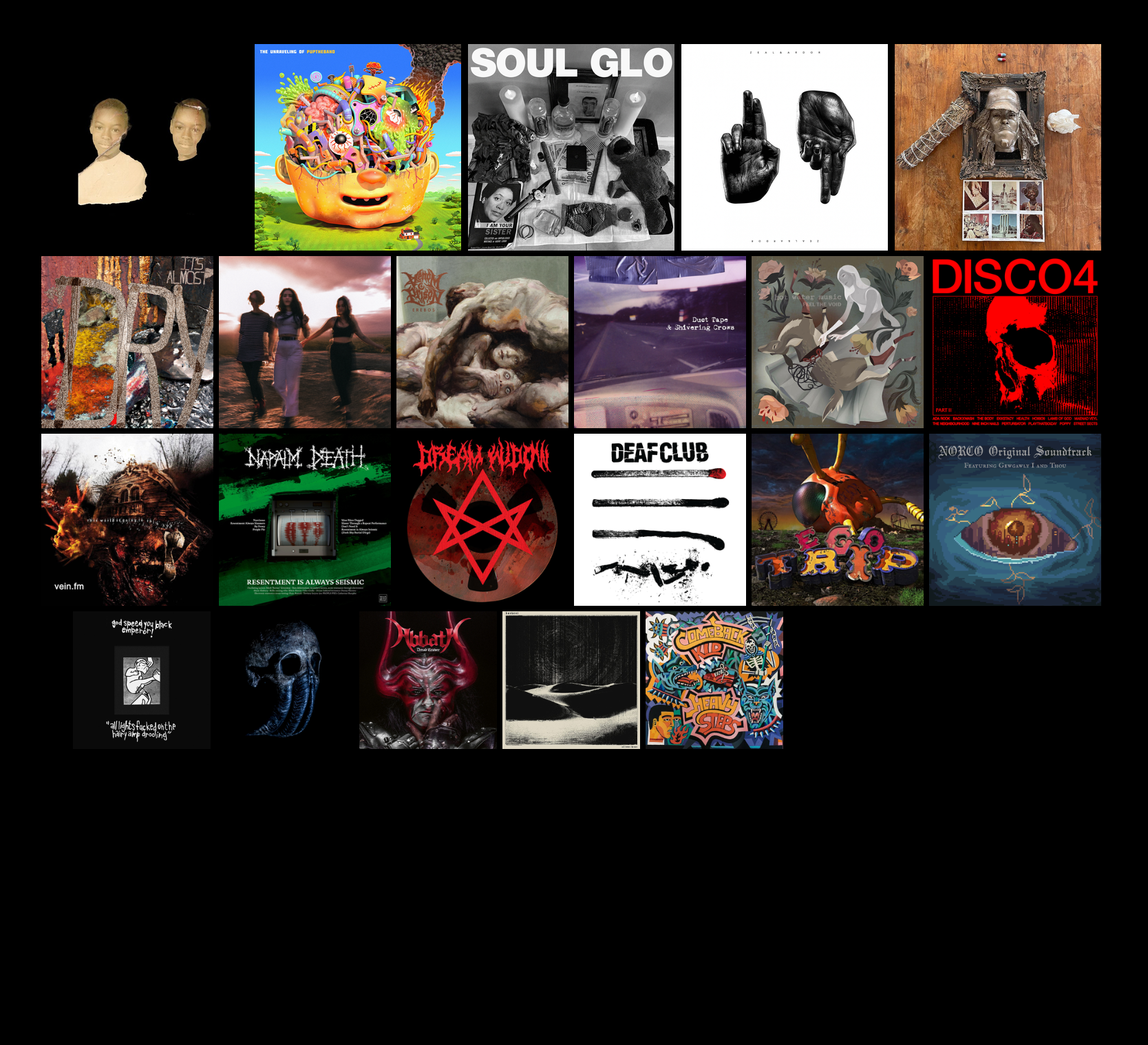I’ve got a couple drafts of list building posts in the works right now. One is for a proper matched play Alpha Strike event (not a tournament) in June and another is about list building in general. This is a little different from that and mostly one I began to write in a fugue state yesterday. The game store where I normally play Battletech has a standing drop-in session every Wednesday. Scenarios get posted the previous Thursday so you have the weekend to prepare. I can’t always make it to the drop-ins (I typically manage to get there at least once a month). I cannot overstate how much work the organizers do for these kinds of things. Local game store organizers are beings of pure light and you should thank them for all of their hard work if you haven’t. When they’re not wrangling with the local game store’s management for table space, they’re crafting inventive and fun scenarios that are welcoming to new players and keep things fresh for the old heads. They’re also probably always mediating those two very different crowds so that everyone feels welcome. What’s more, they’re doing this every week. It’s hard to overstate how quickly these kinds of things can just fold if an organizer misses a week or two. Truly thankless, herculean work.
A lot of these scenarios are built with flexibility and timeliness in mind. They don’t know how many people are going to show up on a given night and they have a handful of hours before the store closes. People need to be able to pull up, put their mechs on the board and get going as soon as possible (most organizers will usually have a spare mech or two for folks who don’t have one or are just in the shop and curious). For a host of reasons, I’m not going to post the entire text of this week’s scenario here, but broadly: it’s a recon mission, you can’t take any mechs that move slower than 10″, things like active probes and electronic countermeasures (ECM) interact with the various objectives, as well. Players are expected to show up with mechs that meet the movement criteria and form a force worth 300 PV to play against the opposing force (in this case, handled by a deck of cards to automate things).
ECM is a special ability that typically has a lot of use in pick-up and competitive formats. It creates a bubble around your mech that can disrupt C3 networks (C3 can be really oppressive in Classic and Alpha Strike as it shares targeting data among all the units on a given network). Also, any unit with Stealth armour will have some form of ECM as that’s how the Stealth armour works. You can turn off Stealth and then use ECM to jam C3 networks if you want and it’s partially why I like the Capellans – a lot of their core mechs will usually have a variant or two with Stealth, meaning I don’t typically need to worry about C3 cheese lists. Active Probes or Bloodhound Probes typically only see play if you’re using the optional Battlefield Intelligence rules or playing a narrative campaign. I love it when scenarios find a use for them because you’re still basically paying PV for them even if they’re largely inert for most formats. Also, Battlefield Intelligence, fog of war, hidden information, macro scale engagements – all of that is probably going to be wrapped up in a separate post I’ve been working on as I read through the BattleForce rulebooks.
I’m a pretty anxious person and try my best to be courteous in these situations. Everyone’s here to chuck dice and see robots explode and I’m happy to oblige someone who has like one or two mechs they really want to put on the table, even if they’re costly. I also tend to use these scenarios as a way to push myself forward on painting projects or building out the never-ending spreadsheets I keep making. So when I prepare for a drop-in game, I usually come with a handful of options and I can pick what feels right for the moment. I have my requirements: under 300 BV, ECM, Probe, minimum 10″ movement. Any era or faction.
The first problem is that fast things tend to be fragile. If you’re on a contested objective, you’re also probably going to be short range to your enemy and then it’s up to the dice gods whether or not you get shot off the table. As the game store is a bit of a drive for me, I’d like to be able to stay in the fight for a bit. The last event I went to, I was out pretty quick and contented myself with controlling the battlefield support vehicles. This time, I wanna stick around. So I booted up MegaMek and did a search for Alpha Strike units that were size 3 or 4 (heavy or assault) and moved a minimum of 10″. I’m still going to pick a couple light fragile mechs for funsies, though.
After some research (and some recent gifts from loved ones) I had a short list of mechs I wanted to paint and pilot that would probably do well. I’ll add photos once I’ve finished painting them up.
- Thug (THG-13U): this thing’s an assault mech with Ballistic Reinforced Armour (cutting damage in half from ballistic sources). There are a decent number of Assault mechs that can move 10″ – I just don’t have them or don’t have them painted. However, this one also has TSM, so I can overheat it to move a bit farther and hit harder in melee. It also has CASEII, so it’s not going to go down from an ammo crit. No ECM, though. 4/3/1 damage at short/medium/long range. I had a spare Thug hanging around and the local game shop was toying around with a mercenary paint scheme, so I figured this was a good excuse to take a crack at it.
- Spartan (SPT-N4): I think I technically painted this one the last time this mission type came up. 10″ movement. Doesn’t hit as hard as the Thug at short range, but can overheat up to 2. It also has CASEII and AMS, so decently survivable. This does have ECM and Stealth, so can contest objectives a little better.
- Ostsol (OTL-9M): Now we’re talking. This moves 16″, has decent armour, also has ECM. I’m a sucker for the look of all the Ost* mechs (Ostscout, Ostsol, Ostroc, Ostwar, uh, there’s a lot). Whether I take this one or not is contingent on how well I can manage to paint the canopy which is kind of a fucking nightmare.
- Assassin (ASN-109): This was in a recent force pack my partner gave me. In the lore, the Assassin is typically viewed as one of the “worst” mechs in the game. It moves a jump-capable 14″, won’t be winning any fights, but is using Angel ECM (and Stealth). It also has CASEII, so it’s not going down from a random through-armour crit. It’s probably got enough juice to take one punch and maybe limp away. I love this fucking thing so much.
- Dola – (DOL-1A or 1A1 – same stats for both): Very fragile, but 16” jump, Angel ECM, and on the off chance it catches a through-armour crit and isn’t already dead, it doesn’t have any ammo to explode on the crit table. I just love the look of this thing and want to force myself to finish painting it. One of the handful of metal minis I’ve put together.
- Ostscout (OTT-9S or 8J): The Ostscout is an ECM and recon platform that someone grudgingly handed a boxcutter before they dropped it from orbit. They’re not there to fight, they’re there to turn on all the lil gizmos in their pocket and make the enemy worse through ECM or your force better (through TAG, spotting, C3, etc.). Their damage output isn’t meaningfully different from a Spider, Dola, or Assassin, so I suspect Alpha Strike’s calculations might have rounded up somewhere because those are all mechs I’d use in a fight in Classic, but I probably wouldn’t bother to pick a fight while using the Ostscout. At any rate, I fucking love the new sculpt for this thing and I’ve been waiting to paint the canopy for a while. The 8J is the premium version: 16″ jump, Angel ECM, Bloodhound Probe, and an all energy loadout, so it won’t get ammo critted to death. 33 PV is a lot to pay for it, but it’s not far off from the Assassin: enough armour to probably take a punch and limp away. The inclusion of the Bloodhound probe probably makes this the more efficient choice for this scenario but I do not care. The 9S is a straight budget version of the 8J: Regular ECM, regular Active Probe, less armour, 9 PV cheaper. If we’re splitting hairs like *that* for a casual game then we have bigger problems.
- Charger C – This mini was in the same force pack as the Assassin. The Charger is another candidate for “worst mech in the setting” and the mirror image of the UrbanMech (an over-gunned, nearly immobile ambushing mech that is almost useless outside of a city), most Chargers are under-gunned, very mobile assault mechs with way too many weird lil recon toys crammed in there. The Charger C (a lot of inner sphere mechs have “C” variants to indicate versions that have been upgraded with Clan weaponry) is an unholy monstrosity and I’m probably going to wind up with a second mini to paint up for my burgeoning Snow Raven forces. The Charger C moves 16″ and hits like a fucking truck (both in melee and when shooting). It takes seriously the premise of the Charger (big armour, fast, a lot of recon toys) and goes “what if this thing also did a lot of damage?” The biggest fight will probably be convincing someone to let me pilot nearly 1/3 of our allocated PV. At an eye-watering 83 PV, it’s probably one of the priciest mechs I’ve seen or even considered fielding (I went on a whole rant about the Charger C that isn’t super relevant here, so I’ve moved that to the end). I’m going to include the CGR-1X1 card in my doc – same movement and general beefiness, but only does one damage at each range bracket and is 30PV cheaper.
- Hierofalcon (Prime, probably, but the A is a little cheaper by 3PV): Also contingent on the paint scheme coming together. I’ve painted the Goshawk (Vapour Eagle) in a scheme I want to share between Snow Ravens and Alyina Mercantile League, but I’ve really struggled to get that consistent on other chassis. Should have just done my desert drab scheme for “every faction that’s not Capellan or Snow Ravens.” This is also an Iron Wind Metals miniature. It’s one of the more recent ones and generally looks good, but some of the details are a little muted by the metal. The Prime moves 12″ on the ground and jumps 16″. It also has ECM and the almighty JMPS1 ability (it adds extra Target Movement Modifier (TMM) when jumping above the usual +1). Its base TMM is 2 and gets that whenever it moves at all. Jumping adds a base +1. JMPS adds whatever number after that, so its TMM goes up to 4. This means that its base difficulty of getting shot (before you calculate intervening woods, pilot skill rating, or range modifiers) is already at 4. A regular skill pilot (4) shooting at short range (so no range modifiers or woods) needs to roll 8 or better on 2D6 to even hit this fucking thing at point blank range. The A is even more gross: it drops the ECM and a few other toys the Prime has but jumps 20″ and has JMPS2. There are four stock mech variants (two of which are the Flamberge, one of the most deeply unfun mechs to play against in the setting), one unique Solaris mech, and one single protomech that have JMPS2. However, I’m less worried about my opponent having fun because my opponent will be a deck of cards automating a bunch of mechs and not an actual human.
- Scorpion (SCP-2N): This is just an excuse to put a Scorpion on the table. I love the new sculpt for it and I’ve been sitting on finishing it up for a while now. It’ moves 16″ and is decently tanky, has CASEII. It doesn’t do a *ton* of damage, though. I could upgrade to the Scorpion C to ditch Tag but with a damage profile of 3/2/2 vs. the 2N’s 2/2/0*. It’s a Quad, though, so it will have a narrower firing arc than other mechs and it has comparable cost to a Hierofalcon.
- Hunchback (HBK-7S): I have a Hunchback mostly painted and this also has AECM and a Bloodhound Probe. It doesn’t (currently) spark joy. I’ve been emulating a paint scheme that’s basically “grimy Comstar mechs” that I saw on Goonhammer. I mostly like it, but once I saw I could do it, the motivation kind of dropped out from under me. I bet someone else will have this one anyways.
- Centurion (CN9-D3D): Just a cheap 16″ movement dork. Once you get into medium mechs, you’re going to find a lot of these guys. The Centurion is one of the first mechs I ever painted, so I have a bit of fondness for it.
Realistically, I’m probably only piloting like one or two mechs off this list, so it’s definitely overkill. I doubt I bring even half these out of the box I transport them in. My current vibe check is: at least the Assassin and maybe the Dola will see some action because they’re both cheap and I will probably advocate for them. After that, Thug or Spartan, whichever I’m feeling more. Then Charger, then Ostsol if I finish it.
On the Charger C and PV in Alpha Strike
To put into perspective just how deliciously unhinged the Charger C is, the Ares ARS-V1C Aphrodite is a superheavy tripod mech. It does 7/7/5 damage (vs. the Charger C’s 6/6/0), has 5 more armour and 6 more structure than the Charger C. And the Ares is a Turret, so it can apply its full damage profile in its rear arc. The Ares mechs aren’t typically something you put into a normal force, you make them a boss fight at the end of a narrative game. The Ares costs three PV less than the Charger C. A good ratio for an “efficient” mech in Alpha Strike is to look at the ratio of PV to mid-range damage and you’re looking for a 10:1 ratio of PV to damage. A 5 damage mid-range mech is generally efficient if it comes in at 50 PV. Obviously higher TMM and movement can skew this a little. Part of why the Charger is so expensive is because it has assault mech armour, decent movement, very solid damage, and a bellyful of recon toys. Normally, something has to give – you want a lot of armour? Get ready to move slow. You want a lot of damage? Get ready to be slow or fragile or both. If you want all the things, get ready to pay for it and honestly? It’s fuckin just about worth it. The Ares is just about in that wavelength, too – not a perfect ratio, but close enough considering the tools it has. Now, the Turkina Z, a mech that is often banned from most formats because it is well past the point of being broken. It’s a mech with so much damage potential that it achieved escape velocity from either BV or PV systems to accurately account for it. The Turkina Z does 15/10/5, has 1 more structure than the Charger C, and also has a fuckton of bits and bobs and toys in it. The Turkina Z only costs three PV more than the Charger C.
The Master Unit List won’t let me search for Alpha Strike units that cost more than 100 PV so I have to assume that’s the ceiling. The only things that are more expensive than the Turkina Z are either siege artillery vehicles or superheavy tanks that are functionally moving garrisons. Most of these have never received official models – probably because the scale of these things should exceed a single hex. You can find STLs online for most of them if that’s the life you want to lead but you’re probably only doing that in a narrative game. The Destrier Siege Vehicle is 90 PV and needs a second line for all its armour pips and is a massive artillery platform with some basic defenses if something gets in close. The Gulltoppr Omnimonitor A is probably the most expensive Alpha Strike unit in the game outside of customs. It’s a nearly efficient 8/9/9, with a juicy 23 armour and 16 structure, but I still don’t think it could take on a single Turkina Z and win consistently.
There’s a larger discussion to be had around the PV system and I need to dig into it a bit. Apparently when Alpha Strike first came out, the formula for calculating PV was explained in the Alpha Strike Companion, so maybe that will answer some of the questions I have. One of the most gnawing questions I have in the back of my head is that Inner Sphere doesn’t quite seem properly balanced against Clans. This is a perennial problem that I think the BV system *mostly* accounts for outside of clear edge cases, but the PV-to-damage efficiency ratio tends to go out of whack with Clan forces. Or put another way: in the lore, the Inner Sphere triumphs over the Clans in a couple of ways: more numerous forces with thicker armour, artillery and battlefield support, and C3 networks. I haven’t quite had that feeling in designing Alpha Strike lists. Finding ways to get Clan tech in the mix is almost always the better decision. The discount on less-efficient Inner Sphere mechs doesn’t quite seem to line up in a way that feels right. Thankfully, that’s easier than ever in the IlClan era as both Inner Sphere and Clan cultures have really had a lot of opportunity to mesh over a century of hating each other’s guts. It’s also a trend I’ve seen with Alpha Strike tournament results (not that I really care about competitive balance in Battletech – one of the enduring appeals is that it’s not striving for that and the rules often stay the same for long stretches) – a lot of people are just playing Jade Falcons because they have direct access to like three of the four JMPS2 mech chassis or Mercenaries (who also have access to two of them in the IlClan era). I’ll probably have more fulsome thoughts after I do some reading and put together some lists for that event in June. Since it’s a casual event, I’ll probably come prepared with a few lists and see how they do (until my brain completely melts and I need to go lie down).
Anyways, I’ll update this post with photos once I get the mechs painted to a reasonable standard and ready to go for tomorrow.
